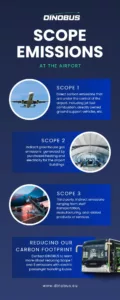One major source of greenhouse gas emissions worldwide stems from the aviation sector. Yet, as passenger volumes grow throughout major airports, air travel will have to scale up operations to accommodate. Understanding the emission categories of Scopes 1, 2, and 3 is crucial for managing and reducing their impact. The Greenhouse Gas Protocol, an accounting tool for comprehending, measuring, and controlling emissions, establishes these scopes and their management.
Scope 1 Emissions
Direct emissions from sources under the airport’s control make up the first category: scope 1 emissions. In the aviation industry, this includes emissions from ground support equipment (GSE) like fuel trucks, baggage tractors, and passenger buses, as well as emissions from the burning of jet fuel. Since the company directly produces these emissions, they are the easiest to measure and control. For example, this scope would encompass:
+ Fuels used by onsite operational vehicles and generators
+ Runway de-icing
+ Fuel used by company owned vehicles
There are many more operations that can fit into the first category. However, these operations are crucial. While the vehicles and equipment can generate substantial carbon emissions, they can also be used as an opportunity to address ESG targets.
Scope 2 Emissions
Indirect greenhouse gas emissions of the airport are referred to as scope 2. Emissions from utilities bought and used at airport buildings, offices, and other operational locations are the main culprits of this category. Although the company itself does not directly cause these emissions, its energy use does, and the use of renewable sources can have a remarkable impact. Scope 2 can be made up of:
+ Heating
+ Electricity
Although not limited to these, the purchase and consumption of energy for these purposes is directly linked to substantial scope 2 emissions. The power is often sourced from the grid or a third party supplier and is critical to keep airports running smoothly and safely.
Scope 3 Emissions
All additional indirect emissions, ranging from upstream and downstream emissions, that take place throughout the value chain are included in scope 3 emissions. The scope 3 category in aviation can result from a variety of actions, including:
+ Emissions from the aircraft manufacturing of purchased aircraft
+ Waste disposal and product distributions
+ Business travel and staff commutes
Because scope 3 emissions encompass such a wide variety of activities, It’s usually the most difficult category to measure and control. Nonetheless, they frequently account for the majority of an airport’s overall carbon footprint.
Addressing Scope 1 and 3 Emissions with DINOBUS
Partnering with DinoBus is a convenient way to address scope 1 and 3 emissions, depending on the airport. Apron buses assume a vital position both in ground handling and in achieving ESG targets. Fully electric airport buses are now the most viable choice for airports switching to green energy.
For airports that own their airside fleets, DINOBUS helps to directly address Scope 1 emissions. The direct greenhouse gas emissions linked to ground support operations are greatly decreased by electrifying passenger transportation. Airports can reduce their overall carbon footprint and their dependency on fossil fuels by making the switch.
Electric apron buses can also support a more comprehensive culture for clean energy. Airports can inspire airlines and operators to follow suit by implementing electric ground support equipment.
A more sustainable aviation industry can be achieved by implementing clean solutions to reduce Scope 1, 2, and 3 emissions. Solutions like bus electrification can remarkably reduce both direct and indirect emissions. Contact us at [email protected] for more information about the best solution for your location.
